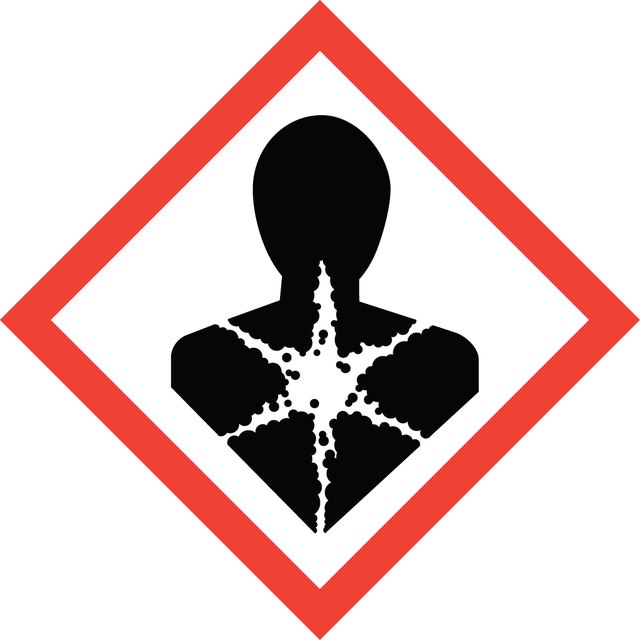登录 查看公司和协议定价
选择尺寸
关于此项目
经验公式(希尔记法):
C9D4H5N3O2
化学文摘社编号:
分子量:
195.21
MDL编号:
UNSPSC代码:
77101502
PubChem化学物质编号:
NACRES:
NA.24
等级
analytical standard
质量水平
同位素纯度
≥98 atom % D
产品线
PESTANAL®
方案
≥95.0% (HPLC)
保质期
limited shelf life, expiry date on the label
应用
agriculture
environmental
包装形式
neat
储存温度
2-8°C
SMILES字符串
[2H]C1=C2C(NC(NC(OC)=O)=N2)=C([2H])C([2H])=C1[2H]
InChI
1S/C9H9N3O2/c1-14-9(13)12-8-10-6-4-2-3-5-7(6)11-8/h2-5H,1H3,(H2,10,11,12,13)/i2D,3D,4D,5D
InChI key
TWFZGCMQGLPBSX-QFFDRWTDSA-N
一般描述
Carbendazim is a systemic benzimidazole fungicide that targets a broad spectrum of fungi pathogens through inhibition of mitotic microtubule formation and cell division.
Carbendazim is not approved in the European Union.
Carbendazim has to be monitored in the Multiannual Control Programmes for Pesticides Residues (MACP), run within the EU and EFTA in/on products of plant origin. Maximum residue levels (MRLs) have been set according to Reg (EU) No 559/2011 for Carbendazim for various products of plant and animal origin from 0.01 to 2 mg/kg.
Carbendazim is widely applied in agriculture, horticulture, forest, and gardening to protect plants such as banana, mango, strawberries, oranges, pineapples, pomes, cereals, sugar beet, fodder beet, rapeseed, ornamental plants, medicinal herbs, and turf grasses. In addition, carbendazim is also used in the paint, textile, paper, and leather industries. Due to its severe toxicity and long-term retention in nature, carbendazim is banned in Australia, most of the European Union (EU), and USA.
Carbendazim was first included in Annex I to Directive 91/414/EEC in 2006 by Commission Directive 2006/135/EC. The MRLs of carbendazim in the EU, Japan, and China were 0.1 mg/kg, 10 mg/kg, and 5 mg/kg, respectively.
Carbendazim is not approved in the European Union.
Carbendazim has to be monitored in the Multiannual Control Programmes for Pesticides Residues (MACP), run within the EU and EFTA in/on products of plant origin. Maximum residue levels (MRLs) have been set according to Reg (EU) No 559/2011 for Carbendazim for various products of plant and animal origin from 0.01 to 2 mg/kg.
Carbendazim is widely applied in agriculture, horticulture, forest, and gardening to protect plants such as banana, mango, strawberries, oranges, pineapples, pomes, cereals, sugar beet, fodder beet, rapeseed, ornamental plants, medicinal herbs, and turf grasses. In addition, carbendazim is also used in the paint, textile, paper, and leather industries. Due to its severe toxicity and long-term retention in nature, carbendazim is banned in Australia, most of the European Union (EU), and USA.
Carbendazim was first included in Annex I to Directive 91/414/EEC in 2006 by Commission Directive 2006/135/EC. The MRLs of carbendazim in the EU, Japan, and China were 0.1 mg/kg, 10 mg/kg, and 5 mg/kg, respectively.
应用
The analytical standard can be used for the following:
- Systemic evaluation of the residue and the health risk of carbendazim from the tea garden to brewed tea
- Analysis of carbendazim in a major European river, effluents discharge and assessing the potential sources of carbendazim in the aqueous environment
- Voltammetric determination of carbendazim in orange juice by glassy carbon electrode modified with hybrid material
- To assess and compare the differential influence of tebuconazole and carbendazim, individually and combined, on soil microbial activity
- Quantitative detection of carbendazim in citrus fruit and cabbage samples by a photothermal assay based on a thermometer readout
法律信息
PESTANAL is a registered trademark of Merck KGaA, Darmstadt, Germany
警示用语:
Danger
危险分类
Aquatic Acute 1 - Aquatic Chronic 1 - Muta. 1B - Repr. 1B - Skin Sens. 1
WGK
WGK 3
闪点(°F)
Not applicable
闪点(°C)
Not applicable
Ruijie Fu et al.
Food chemistry, 351, 129292-129292 (2021-02-25)
The detection of carbendazim (CBZ) is important for food safety and human health. However, most current analytical methods require large instruments and highly trained operators. In order to solve this problem, herein, an innovative portable and quantitative photothermal assay platform
Claudia A Razzino et al.
Food chemistry, 170, 360-365 (2014-10-13)
This paper describes the application of a glassy carbon electrode modified with a thin film of mesoporous silica/multiwalled carbon nanotubes for voltammetric determination of the fungicide carbendazim (CBZ). The hybrid material, (SiO2/MWCNT), was obtained by a sol-gel process using HF
Li Zhou et al.
Journal of the science of food and agriculture, 98(14), 5329-5334 (2018-04-16)
Carbendazim (methyl 1H-benzimidazol-2-ylcarbamate) residue in tea is a public concern. The large gap in the maximum residue limits (MRLs) for carbendazim in tea makes it difficult to conduct pesticide management. Therefore, a systemic evaluation of the residue and the health
Sylvain Merel et al.
Environmental pollution (Barking, Essex : 1987), 239, 512-521 (2018-04-24)
Carbendazim is a fungicide commonly used as active substance in plant protection products and biocidal products, for instance to protect facades of buildings against fungi. However, the subsequent occurrence of this fungicide and potential endocrine disruptor in the aqueous environment
Toxicity, monitoring and biodegradation of the fungicide carbendazim
Singh S, et al.
Environmental Chemistry Letters, 317?329 null
我们的科学家团队拥有各种研究领域经验,包括生命科学、材料科学、化学合成、色谱、分析及许多其他领域.
联系客户支持

